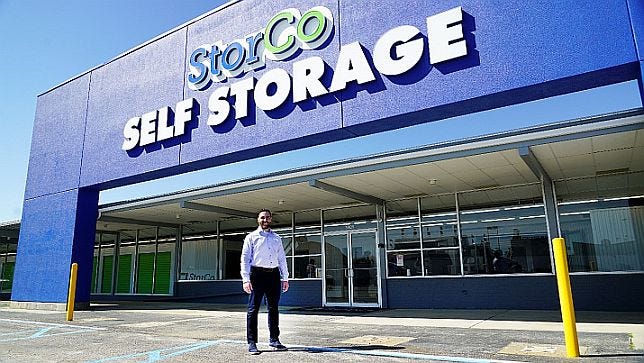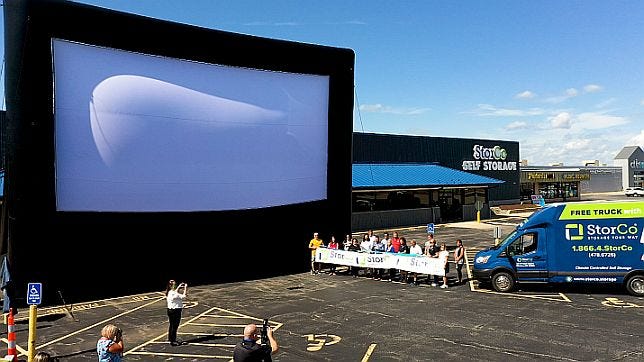Sifting for Self-Storage ‘Gold’: What You Need to Know About Conversion-Development Opportunities
There are thousands of vacant buildings in highly desirable infill markets, and many could be perfect for a self-storage conversion. If you’d like to pursue this type of development, you need to understand how to find a suitable building, get project approval and navigate the nuances of construction. Consider this insider advice.

There are thousands of empty buildings on the real estate market today. Of those, hundreds could be converted to self-storage. But how do you find the select few with the highest potential? How do you discover property ‘gold’ in unlikely places? And how do manage the nuances of this type of construction? Let’s talk about some things I’ve learned through my company’s projects.
Choose the Right Location
While there are many ways to search for potential self-storage conversion opportunities, all developers take one of two approaches: They find an empty building that’s good for self-storage and then research the market to see if it’s viable, or they find a market with proven self-storage demand and search it for suitable vacant buildings. Either way, it’s important to investigate whether there are other storage projects in the planning or development phase. It’s also worth finding out whether there’s any available land that may allow a new storage facility to be built nearby. This’ll help you gauge risk in relation to potential future competitors.
Once you’ve nailed down the ideal market, the specific location will be key. Site selection for a conversion is generally the same as for a ground-up project, but with one major difference: A conversion opportunity is often in an infill location surrounded by other businesses, which limits the chance of a competitor establishing a new facility right next door.
Also, make sure you check the title. You want to ensure there are no covenants, restrictions, easements or other agreements that’ll impact your ability to convert the building or operate the business once complete. I’ve seen private restrictions that prohibit self-storage, maintenance fees, shared utilities and easements that affect circulation. Consult with your real estate attorney to discuss possible limitations.
Assemble the Right Team
Ideally, you’ll find your self-storage conversion site in your own backyard; but in most cases, you’ll need to look beyond your immediate market. Though you may already have a preferred real estate agent, designer, engineer, contractor, etc., I encourage you to include individuals on your development team who are local to the market you enter. Professionals with a history of selling, building and converting in the area will have insight and experience with local agencies to help you streamline the process. They’ll know what the city will approve or dislike and why, which will surely save you headaches down the line.
With their history and rapport, your team of experts can also refer you to other local service providers and manufacturers, which should help you keep costs down and shorten your construction timeline. Another intangible but critical benefit of using a local agent or contractor is they may be able to inform you of any future self-storage developments in the works, so you know if there’s any competition coming. Ultimately, with more experience comes more knowledge, more leverage on deals and more influence within the community.
Understand the Approval Process
Getting municipal approval is potentially one of the most challenging hurdles in the self-storage conversion process. Most cities aren’t excited about the idea of self-storage. It’s imperative to have a plan before you meet with any officials.
Understanding the local zoning requirements for your project is vital. If nothing else, it helps you sound like you know what you’re talking about. That impression combined with your experience in the self-storage industry will help build rapport with the right parties. Personally, I appreciate a more challenging process for the simple fact that it intimidates potential competitors who might not have as much knowledge or determination to do the research and overcome objections from the city.
I’ve also found it advantageous to read about past storage-approval scenarios within the municipality. Most meeting minutes and recordings are public record. This can give you a head start and help you understand what the city is looking for, how the process works and who’ll be present in your own meetings.
Prepare for Buildout
When developing a self-storage conversion rather than a new build, you’re often constrained to the pre-existing building footprint. Depending on the site, the approvals likely won’t allow you to expand outward, which would change the land survey and create a new set of requirements from the city. This leaves one way to go—up!
During your initial research, it’s critical to determine how many floors can be added to the existing structure. Can it support more load from additional floors while remaining within code, or will it require reinforcements? Do you have room for a functional elevator and other necessities? If the building is already multi-story or has a mezzanine, make sure the floor load is up to code and adequate for self-storage use.

For a conversion project, it’s imperative to work with a contractor who specializes in self-storage. They’re experienced in inspecting a building from top to bottom through the lens of industry needs. They’ll advise on the roof structure, internal components, basic foundation and walls, parking lots, mechanical, etc. They can also tell you whether you can reuse the existing access points or systems, including HVAC, electrical, sprinkler, etc.
All of these things can help you save on construction costs. Most commercial buildings are sold as-is, and any deferred maintenance items can get costly if they aren’t diagnosed during contract negotiations. It’s also common to see environmental problems that are expensive to remedy, especially with older manufacturing and warehouse sites. An industry-experienced contractor can help you sidestep these pitfalls.
Look for Other Ways to Save
In a self-storage conversion, you can often purchase an existing structure for less than it would cost to build it from the ground up. Even with all the construction expenses, you’ll have a lower budget—assuming you maintain the same footprint, access points and general site circulation. You also get to skip some of the site-plan approval process with the city, so you can start the project sooner. Overall, the development process might be more than a year shorter than a new build, which means you’ll get to lease up sooner and start profiting faster. Time is money!
Depending on the location, there may be other incentives as well such as qualified opportunity zones, city-improvement credits, energy credits, historical tax credits and finance eligibility for PACE (property assessed clean energy) programs. Energy-efficient improvements are also a great consideration. Some that are often overlooked include smart lighting systems (based on motion detection), solar-energy panels, smart thermostats and automatic doors.
Use All the Land Opportunity
Even at the development phase of your self-storage project, you should be thinking about how the facility will operate. The great thing about conversion properties is they often come with a large parking lot (think big-box stores). If you aren’t going to fill it with rentable storage, consider how it can be used to help your business in other ways, particularly while you’re generating public awareness.

For example, my company has hosted many community events including a carnival, drive-in movie nights, seasonal farmers markets, and sales of fireworks and Girl Scout Cookies (separately, of course). Any chance to create organic traffic brings in more customers. What’s more, if you can bring these plans to light during the approval process and show the city how you plan to be a good neighbor, it may help smooth your path. Consider all the above from the start of your self-storage conversion project, and you’ll be better equipped to find that golden opportunity you seek.
James Reid is a founding principal of Investa Group, a national investment firm primarily focused on the storage sector. He began his career in the self-storage industry as the founder of StorCo Storage, where he’s the primary acquisition and development liaison. His history of outside the box thinking on his prior developments provides unique insight into the zoning and approval processes. To reach him, call 314.250.7000 or email [email protected].
About the Author(s)
You May Also Like





